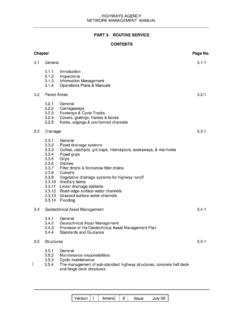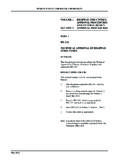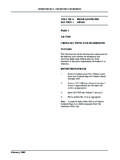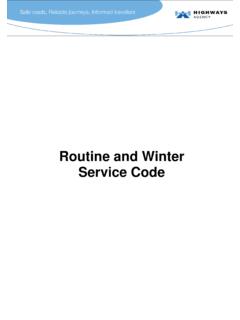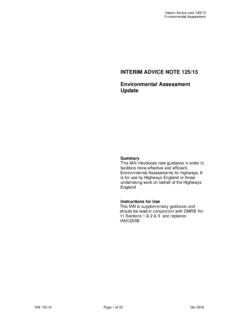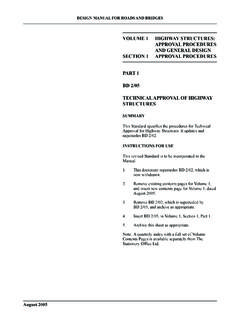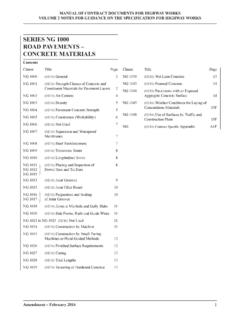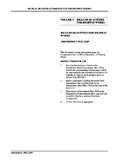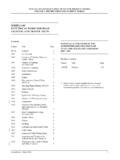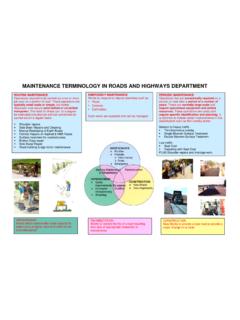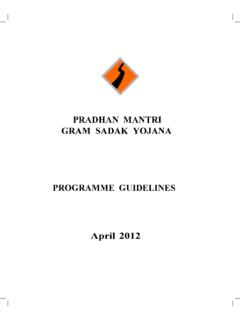Transcription of Vehicular Access to All-Purpose Trunk Roads
1 THE HIGHWAYS AGENCY TD 41/95. THE SCOTTISH OFFICE DEVELOPMENT DEPARTMENT. THE WELSH OFFICE. Y SWYDDFA GYMREIG. THE DEPARTMENT OF THE ENVIRONMENT. FOR NORTHERN IRELAND. Vehicular Access to All-Purpose Trunk Roads Summary: This Standard sets out mandatory standards for the geometric layout of connections for direct Vehicular Access to All-Purpose Trunk Roads where the numbers using the connection are below 500 AADT. The Standard describes the effects of Vehicular Access to Trunk Roads and outlines the results of recent research on the safety implications. Volume 6 Section 2. Part 7 TD 41/95 Registration of Amendments REGISTRATION OF AMENDMENTS. Amend Page No Signature & Date of Amend Page No Signature & Date of No incorporation of No incorporation of amendments amendments ELECTRONIC COPY - NOT FOR USE OUTSIDE THE AGENCY.
2 March 1995 PAPER COPIES OF THIS ELECTRONIC DOCUMENT ARE UNCONTROLLED. Volume 6 Section 2. Registration of Amendments Part 7 TD 41/95. REGISTRATION OF AMENDMENTS. Amend Page No Signature & Date of Amend Page No Signature & Date of No incorporation of No incorporation of amendments amendments ELECTRONIC COPY - NOT FOR USE OUTSIDE THE AGENCY. PAPER COPIES OF THIS ELECTRONIC DOCUMENT ARE UNCONTROLLED March 1995. DESIGN MANUAL FOR Roads AND BRIDGES. VOLUME 6 road GEOMETRY. SECTION 2 JUNCTIONS. PART 7. TD 41/95. Vehicular Access TO ALL. purpose Trunk Roads . Contents Chapter 1. Introduction 2. Geometric Standards for Direct Access 3. road Users Special Requirements 4. Other Considerations 5. References 6. Enquiries Annex 1: The Effects of Providing Vehicular Access Annex 2: Results of New Research on the Safety Implications of Vehicular Access ELECTRONIC COPY - NOT FOR USE OUTSIDE THE AGENCY.
3 March 1995 PAPER COPIES OF THIS ELECTRONIC DOCUMENT ARE UNCONTROLLED. Volume 6 Section 2 Chapter 1. Part 7 TD 41/95 Introduction 1. INTRODUCTION. Scope Separated Junction, (TD 22 DMRB or TD 40. DMRB ) depending on the level of use of the Where Vehicular Access has been approved this connection, the traffic flow on and the nature of the Trunk Standard sets out requirements to be met in providing or road in terms of the general level of junction provision improving such Access to an All-Purpose Trunk road , along the length. Where the flow likely to use the including geometric and visibility standards. It covers both connection falls below 500 AADT, and the connection is a single and dual carriageway All-Purpose Trunk Roads in direct Access as defined in para , then this Standard urban and rural areas. The Standard reviews the traffic and shall be used for the design of the geometric layout.
4 Safety implications and stresses the need for only the minimum number of well engineered connections in safe The figure of 500 AADT relates to continuous positions. use. It may be that an Access is used less regularly but when it is, the use on that occasion exceeds this figure by a General considerable amount. The Access may then require some form of specific traffic control. It is for Overseeing This Standard replaces TA 4/80 (DMRB ) Organisations to decide what provision is appropriate Access to Highways - Safety Implications, which is based on this peak use and the frequency of it occurring. It withdrawn. For England, this Standard should be read in is unlikely that a roundabout connection would be conjunction with Circular Roads 4/88 and Planning appropriate in this situation as this would impose Policy Guidance Note No.
5 13 on Transport (March geometric delay permanently on Trunk road traffic. 1994). In Wales, the circular is Welsh Office Circular 42/88 and the Planning Policy Guidance Note 13 is that published in 1988. These documents do not apply to The primary purpose of the Trunk road Northern Ireland, and Scotland. This Standard provides network is to provide for the safe and expendious technical information related to Access policy but does not movement of long distance through traffic. That set out such policy. means strictly limiting the number of direct accesses to Trunk Roads . It means ensuring that the full In the case of England and Wales, local planning implications for traffic and road safety are taken into authorities have the responsibility for making decisions on account when proposals are made for new direct accesses and their spacings where the all purpose development in the vicinity of Trunk Roads .
6 This is Trunk road is subject to a 40 mph speed limit or less. whether it involves new Access or increased use of existing accesses, particularly onto dual This Standard updates the previous advice and carriageways where speeds are high. Limiting direct introduces geometric standards. It includes the results of Access remains a prime objective of the Overseeing recent research work in this country. It also draws upon Organisations. overseas experience. The opportunity has been taken to include full mandatory geometric and visibility requirements which extend TD 42 (DMRB. ). Other It has been accepted for more than 50 years ever changes include widening the scope of the Standard to since the 1936 Restriction of Ribbon Development Act consider the needs of all road users including pedestrians, that if Trunk Roads are to perform satisfactorily as channels cyclists and equestrians.
7 For longer distance traffic, the number of connections for Vehicular Access must be limited. Access traffic has three Connections for Vehicular Access to an all purpose effects, it adds to the traffic on the Trunk road , it slows Trunk road range from a field gate with a verge crossing or other traffic, and it can give rise to accidents. What the a direct Access serving a single dwelling or development new research reported here shows is that connections for up to a road designated as unclassified and serving a Vehicular Access are one of a number of features which number of developments or a large single development. If figure in the safety risk on the Trunk road network. The the total amount of traffic forecast to use the connection key to providing a safe connection is to ensure that it is exceeds 500 vehicles per day (AADT) then it should be sited correctly, has adequate visibility and that it is designed according to the appropriate junction Standard.
8 Designed so that joining and leaving traffic can do so This would be for either a Major/Minor Priority Junction without impeding through traffic. There are likely to be (TD 42 DMRB ), a Roundabout (TD 16 DMRB few places on Trunk Roads where even these conditions can ), a Signalled (TA 18 DMRB ) or Grade be met. ELECTRONIC COPY - NOT FOR USE OUTSIDE THE AGENCY. March 1995 PAPER COPIES OF THIS ELECTRONIC DOCUMENT ARE UNCONTROLLED 1/1. Chapter 1 Volume 6 Section 2. Introduction Part 7 TD 41/95. Accident records for all Roads , as set out in "The Casualty Report" ( road Accidents in Great Britain Definitions 1992) show that in urban areas 70% of accidents now occur at junctions and accesses, and about 38% of The terminology follows where possible the accidents in rural areas. In 1980, when TA 4/80 (DMRB definitions contained in BS 6100 : Subsection ) was published, the figures in road Accidents in 1990.
9 Great Britain 1980 for accidents at junctions and accesses showed 66% in urban areas and 33% in rural The following additional terms have been areas. In the intervening 12 years, accidents away from defined for use in this Standard. junctions have fallen 14% to just under 90,000 in the year. Accidents at junctions and accesses remain almost Direct Access : a connection to an All-Purpose Trunk constant having reduced by only 2% to 143,000. But on road for the use of road vehicles, serving or intended Trunk Roads in rural areas in 1991 there was a higher to serve, one or more properties, and linking directly proportion of accidents at junctions and accesses, 47% of to the site. accidents on dual carriageways and 51% on single carriageway occuring there. These figures are explored Junction : a meeting of two or more Roads .
10 Further in Annexes A1 and A2. Minor Junction: a meeting of an unclassified road or a classified unnumbered road with the All-Purpose Implementation Trunk road This Standard shall be used forthwith on all Major road : is a road on which traffic has a priority schemes for the construction, improvement, and of movement over that of other Roads . maintenance of All-Purpose Trunk Roads , currently being prepared provided that, in the opinion of the Minor road : is a road on which traffic concedes Overseeing Organisation, this would not result in priority to the traffic on the major road . significant additional expenses or delay progress. Design organisations should confirm its application to Roads : Urban and Rural : as defined in TD. particular schemes with the Overseeing Organisation. 20(DMRB ), namely that an urban road is a road in a built up area which has either a single carriageway with a speed limit of 40 mph or less or is a dual carriageway or is a motorway with a speed limit of 60 mph or less.
